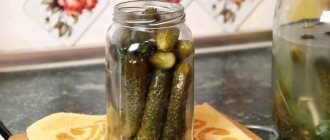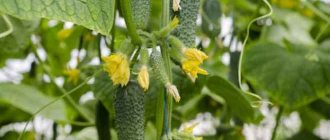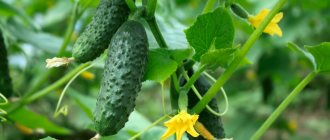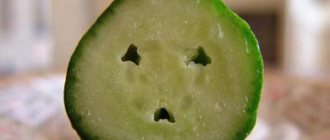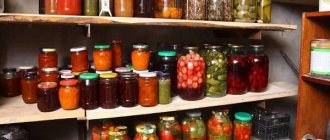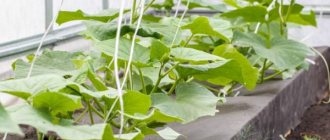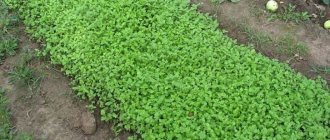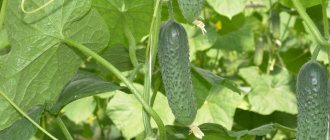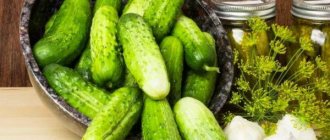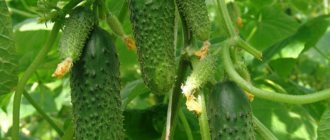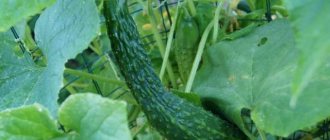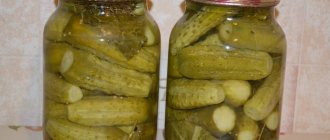What are they?
The pelleted seed variety is a hybrid cucumber that undergoes additional processing. As a result, they acquire features with the help of which the culture adapts to unsuitable climatic conditions. The plant also easily finds nutrients, regardless of the depleted soil composition. Cucumbers fight against insect attacks and diseases.
For the procedure, small-sized seeds are selected, since after panning they become large. The large seeds themselves are selected. The pelleting procedure makes it easier to work with planting material. During planting, it is clearly visible in the garden bed. The bright color helps a person navigate and remember to sprinkle the seeds with soil.
Cucumbers that have undergone pelleting in Poland do not require thinning after seedlings emerge.
General information about seeds from Poland
Poland supplies our country with ready-made, often hermetically sealed seeds that do not require any additional processing. All you need to do with them is simply plant them in the ground (or greenhouse) and properly care for them. Recently, the so-called pelleted varieties of seeds have become very popular in our country.
A pelleted variety of seeds from Poland is a type of hybrid cucumber that has undergone additional processing, as a result of which they acquire features that help them better withstand harsh climatic conditions, find nutrition in conditions of depleted soil composition, and withstand the invasion of diseases. Most often, small seeds are subjected to this procedure, because the process itself significantly increases the size of the seed. Such seeds are much easier to plant in the ground; they are clearly visible in the garden bed (because they have bright colors) before they are covered with a layer of soil.
An important advantage of pelleted seeds supplied from Poland is the fact that cucumbers do not require thinning at all.
Let's try to look in more detail at what the shell of the coated seed consists of. Firstly, it is worth noting that the coating itself is quite strong in consistency, which significantly increases the chances of germination. Secondly, the “armor” that covers the hybrid seed is also a nutrient medium. After entering the moistened soil, a complex of nutritional components is activated in the shell, allowing the future bush to grow better and protect itself from diseases and pests.
What is the peculiarity of such seed treatment as conceived by Polish producers? Everything is quite simple: a seed planted in the ground already has the necessary growth potential (microelements, nutrients), which only needs to be activated. If everything goes well, the seedlings will be stronger and grow crowded and evenly. As soon as the seedlings emerge from the ground, the owner of the garden bed only needs to actively water them and feed them, if necessary.
Why do you need abundant watering? The answer is obvious: to dissolve the seed shell, thereby launching growth processes. It is worth noting that pelleted seeds, which mainly come to us from Poland, will help greatly save the effort and time of those who care for them. Apart from watering, they do not require active care.
The process of planting Polish hybrids is quite simple. You should not do any pre-soaking, germinate the seeds before planting, worry about temperature changes and fear that small sprouts may die.
Like most other hybrids, cucumbers grown from pelleted seeds have excellent characteristics: they are tasty, crunchy, without bitterness. They contain a full list of vitamins and microelements, and they can remain fresh for a long time after being collected.
Let's take a closer look at several varieties of seeds from Poland and find out the distinctive features of each of them.
Polish cucumbers Andrus
Andrus f1 is a high-yielding variety with a female flowering type. The mid-early crop is intended for growing in open soil. The ripe fruit is a cylindrical gherkin. The whole body is covered with tubercles. The cucumber has a light green color with expressive light stripes.
The long, regular shape provides an attractive presentation. The characteristic cucumber taste of Zelentsy is not bitter. Fruiting continues until the end of the first autumn month, and the cucumbers ripen evenly. Suitable for canning assorted vegetables and pickles. Fresh dishes are prepared from it.
Mid-early hybrid Titus
As a result of Polish selection, another species was bred - cucumber Titus f1. Designed for planting in open ground. Fruiting occurs 1.5 months after planting the seeds. The female type of flowering of the hybrid is cut down by bees.
For normal growth and development, the crop needs constant watering and warmth. The yield at the end of the season depends on the fertility of the soil. The crop does not need mineral and organic fertilizers, but responds well to them. Sown in the ground after the threat of late frosts has passed. Before this, the soil warms up to 12 °C.
The bush is characterized by rapid growth and has the ability to regenerate fruits. This makes it possible to extend the harvest until late autumn. The tuberosity of the fruit is average. Short greens begin to form from the beginning of crop growth. The plant is resistant to many cucumber diseases.
See also
How to grow a good harvest and accelerate the growth of cucumbers in open ground and greenhouseRead
General characteristics of related hybrids
All hybrid varieties of Polish selection belong to bee-pollinated varieties. This description means that cucumbers cannot be planted in a greenhouse, or the presence of bees indoors is required. But most often, Polish cucumbers can be successfully grown in open ground: on warm beds, under temporary shelters or directly in the garden.
Hybrids produce predominantly female flowers and are characterized by high yield and early ripeness. The first greens can be harvested 40-45 days after sowing the seeds. Reviews from gardeners note the ability of cucumbers to produce extended fruiting. If agricultural practices are followed, fruits can be removed from the vines until frost.
Polish cucumbers are resistant to peronospora and powdery mildew. Genetic immunity to cucumber mosaic allows you to avoid losing crops due to this common disease. All hybrid varieties easily tolerate sharp temperature fluctuations in mid-summer, when after hot and dry weather a period of cold rains begins.
Cucumber Andrus F1 and similar hybrids Krak, Soplitsa, Sremsky and others are classified as gherkin-type varieties. They form a large number of small greens, up to 10-12 cm long and weighing about 90 g. The fruits are cylindrical, with a diameter of only 2-3 cm, do not barrel even when overripe and retain an attractive appearance for a long time.
The cucumber peel is dense, but when eating fresh vegetables it is practically not felt. It reliably protects cucumbers from withering during transportation and storage. Zelentsy do not lose marketable condition for several days after picking; at home they can be stored in the refrigerator for up to 7 days.
The color of the skin is dark green. All Polish varieties have a noticeable light area at the tip of the fruit and thin light green short stripes. The tuberculation is average; as the fruit grows, the tubercles become rarer and less noticeable. They have blunt light spines.
See also
Description of the best varieties of pickling and barrel cucumbers for greenhouses and open ground
Read
The inside of the fruit is white or slightly greenish. The seed chamber occupies 2/3 of the diameter of the greens, but grains do not form in it. Most of the capsules remain empty. The consistency of the pulp is crispy and juicy. Characteristics of taste qualities given by gardeners may be as follows:
- Sremskiy cucumber F1 has a neutral taste and delicate aroma that does not overwhelm the smells of other ingredients in the salad or appetizer;
- Krak is a hybrid with a pronounced aroma and sweetish pulp;
- cucumber Titus F1 is good for canning; gherkins reach only 8 cm in length;
- Andrus and Soplitsa are varieties with light-colored greens, sweet pulp with a crunchy, firm consistency.
All varieties are distinguished by a complete absence of bitterness in taste, even under unfavorable conditions.
The purpose of gherkin hybrids is universal. Fresh cucumbers are delicious in slices and salads and complement gourmet snacks well. They become an integral ingredient in okroshka, Korean kuksi and cold soups, and overgrown fruits can be used to make soft drinks.
To preserve cucumbers longer, they are cold-salted with a small amount of salt. Lightly salted cucumbers are just one of the options for summer preparations that are not canned for long-term storage. You can prepare Korean cucumbers, pickles and other snacks that cannot be stored for more than 1-2 weeks.
Gherkins are ideal for winter storage: calibrated small cucumbers are appropriate either in an assortment of vegetables or in a separate jar. They can be included in a vegetable salad or snack; there are also recipes for lecho with cucumbers.
Popular Polish variety Soplika
Soplika or Soplitsa is a hybrid that has one important feature. Thanks to the careful work of agronomists, the crop gained the ability to bear fruit for a long period. Summer residents who have many years of experience in growing vegetables claim that the right approach allows you to have fresh cucumbers before the first frost. The vegetable is resistant to temperature changes, especially at night.
One cucumber can reach 12 cm in length. More often there are specimens whose length does not exceed 7 cm. A slight change in size does not affect the presentation. A larger shift is a plus for the vegetable and the person who grows it.
Zelentsy is used for pickling, canned whole or chopped by adding other vegetables. The fruiting period of the crop begins in mid-July. The plant produces its last vegetables at the end of September. The green fruit of European origin is not susceptible to a large number of diseases that affect classic cucumber and pumpkin seeds.
Even after one growing season, the hybrid received positive reviews both in our country and at home. The cost differs from other varieties, it is slightly higher. But this is not a reason to be upset. The price is fully compensated by the high yield and many other advantages. Buying one package and planting it will take a person less time than caring for classic seeds.
Large harvest of Krak cucumbers
To create hybrids that will have decent characteristics, several types of cucumbers are crossed under special conditions. As a result, the new crop is able to resist many diseases and produce a large harvest of high quality. Krak f1 is a cucumber variety that was also bred by Polish breeders. Over the course of its existence, it has received many awards for participation in international exhibitions.
The greens that appear on the bush from flowers are cut down by bees. To plant seeds, use the same method as when sowing traditional varieties - in open soil. The only condition is that the temperature of the ground and air must warm up to 15 °C. Sow cucumbers to a depth of no more than 3 cm. To retain moisture, you can use film.
The further stage of cultivation includes:
- Weeding the beds. Weeds are removed as they grow so that they do not interfere with the normal development of cucumber bushes.
- Loosening the soil. Provides the crop with useful substances.
- Watering with heated water. It is carried out in the evening after sunset.
Ripe Krak fruits are covered with a dark green skin. It has no bitterness. The weight of one fruit can reach 115 g. On average, 3.5–5 kg of vegetables are harvested from one square meter. The immune system of the variety helps cope with diseases such as downy mildew and cucumber mosaic.
See also
How to blind cucumbers in open ground and greenhouseRead
The best Polish cucumber hybrids: TOP 10
Nowadays, there are many, several hundred seeds of cucumber varieties and hybrids on sale. Which cucumber seeds are best? What are the differences between cucumber seeds and F1 hybrid seeds? Only 9% of the seeds are non-hybrid seeds. All the rest are hybrids, with F1.
If you decide to plant cucumbers in a greenhouse, then it is better to choose seeds of hybrids that do not require pollination and some that are non-pollinated. That is, parthenocarpic. They do not require pollination to produce fruit.
You should also take into account:
- What if the purpose of planting cucumbers is mainly for canning, then it would be better to choose any gherkins.
- If you need cucumbers mostly for salads, the purpose with the same name, salad, is suitable. They are longer in size than gherkins, 20-25 cm. But according to reviews, they are much tastier fresh.
- If you grow cucumbers with the aim of selling them, then their main criteria will be external beauty, pleasant taste, and at least good transportability.
Which cucumber seeds are best? Let's consider popular cucumber seeds specifically for central Russia.
Bouquet F1
This is a universal variety, in absolutely every sense. Experts recommend growing both in open ground and indoors. Suitable for salads or fresh consumption, and perfect for canning.
As a result, it turns out to be of medium height. Interestingly, it has a bouquet type of flowering and fruiting. Zelentsy are harvested when they begin to weigh 90-110 grams. According to reviews, they turn out very tasty. Another “plus” of these cucumbers is that the variety is almost immune to infectious diseases. The harvest reaches 5-7 kg with proper care.
Buyan F1
Begins to bear fruit quite early.
- On the 44th day after the first shoots.
- Intended for preparation in salads and for preparation.
The cucumbers are short in size and have a beautiful regular shape. The variety is delicious. If we talk about the harvest, it can reach 15 kg per square meter, with, of course, proper care.
The envy of everyone
The variety ripens early. It bears fruit to the envy of everyone with gherkins. Demonstrates high yields both in open ground and in temporary greenhouses. Resistant to almost all diseases and bad weather. Returning to high yields: they will be produced under almost any conditions, including when there is a lack of daylight.
These cucumbers bear fruit right up to frost. More than 3 ovaries are formed in each node. The fruits are medium size, 9-12 cm. Dense, crispy.
Herman F1
This variety is recommended by Rosreestr for growing in any conditions. On open ground, under temporary shelter, in protected greenhouses. Herman cucumber has no bitterness. Moreover, this is a genetic trait. If we talk about the pulp, it is medium in density.
- The average fruit weight is 70-90 g.
- The average yield is 9 kg per square meter.
Tasty both fresh and canned. The variety is also tasty in various marinades. It is not susceptible to most of the diseases that are typical for cucumbers and pumpkins in general.
Green stream
Within just 45 days, this variety grows to fruiting. Quite a lot of greens grow on one node. As many as 5. Can be grown both in protected and open ground.
READ MORE: Zozulya f1 cucumbers: characteristics and description of the variety, photos, reviews
The average length of the fruit is 11-13 cm. Their shape is usual, cylindrical. The taste is sweet and aromatic.
Many interesting varieties come from China:
- Chinese disease resistant;
They give excellent results in terms of yield both in open areas and in various types of greenhouses. They feel equally good both in open sun and in partial shade. What's most interesting is that they don't require special care. The only thing that should be emphasized is that Chinese varieties need support.
Do you think cucumbers from China are less demanding to care for?
Armenian cucumbers
By analogy with the Chinese ones, which were developed by Armenian scientists. The most popular of them are White Bogatyr and Silver Melon. Each variety can be grown both in a greenhouse and in open ground. But their taste is less pronounced than that of Chinese ones. Although they are much larger.
Crystal Apple
It cannot be called a work of British scientists. What is unusual about this variety is that they resemble lemons in appearance. While the taste has nothing in common with this fruit.
White cucumbers
Of course, their unusualness lies in the color of the fruit. The most popular of them are the following varieties: Snow Leopard, Bride, Italian White. And some others. What else is interesting about these cucumbers? They can be planted in open ground and greenhouses. They are able to withstand very high temperatures, up to 45 degrees.
Externally, this cucumber looks more like small watermelons. Moreover, in terms of growing technology it is not very different from ordinary cucumbers.
Of course, all seeds should be purchased only from trusted companies. The first thing you need to pay attention to is the packaging. The manufacturer must be indicated on the package of seeds, with its contacts, at least an address and telephone number.
Snot F1
They can be called the most popular hybrid, which have a mid-early flowering period. A special feature of this variety is its very long fruiting period. The variety is able to bear fruit until autumn.
Sremskiy F1
It does not require special treatment; thermal treatment is also included in this list. A package of seeds most often includes as many as 50 seeds. This makes it possible to hope for a good harvest. The unusual thing is that these seeds can be immediately planted in the ground. It is not necessary to wait until the optimal time to start sowing.
Racibor F1
Yield indicators can be called competitive with other varieties. Another advantage over others: they can withstand even the worst transportation conditions. It can often be found on the ridges of Moldova and Ukraine. There is a warmer climate than in the main part of Russia.
Krak F1
A distinctive feature of this variety is its consistently high yield. It is most noticeable in the first, initial stages of maturation.
Anulka F1
What's unusual about this hybrid? First of all, it is resistant to almost any temperature changes. Including sudden ones. And, of course, to night frosts.
You can also watch a video where they will tell you what the advantages and disadvantages of choosing varieties of Polish selection are.
How to generally navigate the abundance of cucumber varieties and choose the right ones is described in detail and consistently in the article Selecting cucumber varieties. Let me briefly recall the main points.
Despite the fact that the division of cucumbers into early, middle and late is somewhat arbitrary, the choice of variety will depend on the answers to these 3 questions. For example, early ones are more susceptible to disease, and their fruiting period is much shorter than that of later ones.
When choosing a variety, you should pay special attention to resistance to the main species of diseases that most often affect cucumbers in the middle zone: powdery mildew, downy mildew and bacteriosis. If the disease does happen, the “Ambulance” for cucumbers will help to cope with the misfortune: prevention and treatment of diseases.
Not every variety of cucumber is suitable for pickling
By the way, the secrets of growing cucumbers have already been discussed in this article, and it may also be useful when choosing varieties.
Well, having finished with the theory, we will move on to descriptions of the most popular cucumber varieties in the middle zone for greenhouses, open ground, shady areas and home gardens.
'Goosebumps F1'
An early ripening (from 42 to 45 days after sowing), parthenocarpic (that is, self-fertile, not requiring pollination), high-yielding hybrid produced by agro (our review tells more about this and other seed producers). Plant of bunch type, medium height; side shoot growth is limited.
The fruits are large-tubercular, with small black spines, up to 8–12 cm long, distinguished by high taste (they are genetically free of bitterness), versatility: good both fresh and for pickling.
Parthenocarpic varieties and hybrids are preferred for greenhouses. Very resistant to true and downy mildew, suitable for growing in greenhouses, greenhouses, and open ground.
'Tom Thumb'
An early ripening variety (fruits already on the 39th day) with a female type of flowering, characterized by resistance to a whole range of diseases. Zelentsy grow no more than 11 cm in length and gain a weight of about 50-65 g. The fruits are excellent for canning and pickling.
'Benefit F1'
Early ripening (43-50 days from germination to fruiting) self-pollinating hybrid of the female type of flowering. Zelentsy weighing up to 100-120 g and 10-12 cm long, densely covered with small tubercles, devoid of bitterness and are distinguished by high taste. Universal purpose (salting, pickling, fresh consumption). The hybrid is very resistant to true and downy mildew and root rot.
'Alekseich F1'
Early ripening (from germination to fruiting – 37-43 days) parthenocarpic hybrid of female flowering type. The plant is medium-sized, the fruits are slightly tuberous, weighing 60-80 g, 7-8 cm long, the greens are distinguished by excellent taste. The hybrid is extremely resistant to powdery and downy mildew.
'Emelya F1'
A universal early-ripening parthenocarpic hybrid, the fruits of which are successfully used both fresh and for pickling. It grows and bears fruit better in heated greenhouses. The fruits ripen quickly (40-45 days). The bush is indeterminate (with unlimited growth of vines), with a predominantly female type of flowering and bunched ovaries.
The general principles that should be followed when choosing “greenhouse” cucumbers are set out in the article How to choose varieties of cucumbers for greenhouses.
'April F1'
An early-ripening universal hybrid, fruiting of which occurs 45-55 days after emergence. It can be successfully grown not only in open ground, but also in small balcony boxes - the plant is compact and has the ability to self-regulate branching.
General Features
Dried greens from Sremsky
Polish breeders advise trying another variety of vegetables - Sremsky cucumber f1. Like other types of vegetables, it went through the process of panning. One package contains 50 seeds, which allows you to grow a large harvest. Gardeners who did not use up the material in one season can safely plant it the next year.
It takes 5-6 weeks for greens to ripen. In the southern regions of the country, the harvest is enjoyed much earlier, as climatic conditions allow it. The female hybrid is characterized by a developed stem with sufficient width. The base is powerful and strong. The first cucumbers have a smooth cylindrical shape with a rich, bright green hue.
The Sremski cucumber does not require pre-treatment, like other Polish representatives.
Harvesting begins after the fruits are 9–11 cm in length. The appearance of smaller greens is possible. This cucumber variety bears fruit without problems. On average, the weight of vegetables can reach 125 g.
The cultivation of the Srem variety is due to its high taste qualities. Even true gourmets will appreciate its aroma and delicate taste. They are consumed with great pleasure fresh, canned and pickled. Cucumbers form the basis of most appetizers, served separately or together with other vegetables. Greens have a neutral taste, so they do not overwhelm other flavors.
Landing
The seeds are supplied coated - in a colored shell of stimulants and fungicides. Therefore, pre-sowing soaking is not necessary. For seedlings, one seed at a time is placed in small peat pots, watered abundantly and germinated in a warm place. Then the seedlings require moderate temperatures - about +18-20.
You can sow directly into the soil if it has warmed up to +14-16 degrees. In the fall, the bed needs to be fertilized, dug up and loosened.
Pelleted seeds need plenty of watering after planting. With poor watering, the shell will slowly dissolve and the plantings will not sprout well.
Other varieties
Polish cucumbers, like other vegetables, have recently become famous for their excellent taste and good fruiting. They are safely recommended for connoisseurs of hybrids. The varieties are characterized by high productivity. It is not for nothing that Zelenets have been awarded many awards at agricultural exhibitions.
Popular Polish varieties:
- Polan f1.
- Caesar f1.
- Anulka.
- Aladdin.
- Parisian gherkin.
- Paris.
- Isis.
- Racibor f1.
Each description of the cultures represented has significant differences. Some gardeners and farmers prefer early varieties, others choose mid-season and late varieties. A person’s choice also depends on the ultimate goal. Early varieties are grown for fresh consumption, while late varieties are suitable for pickling and canning.
